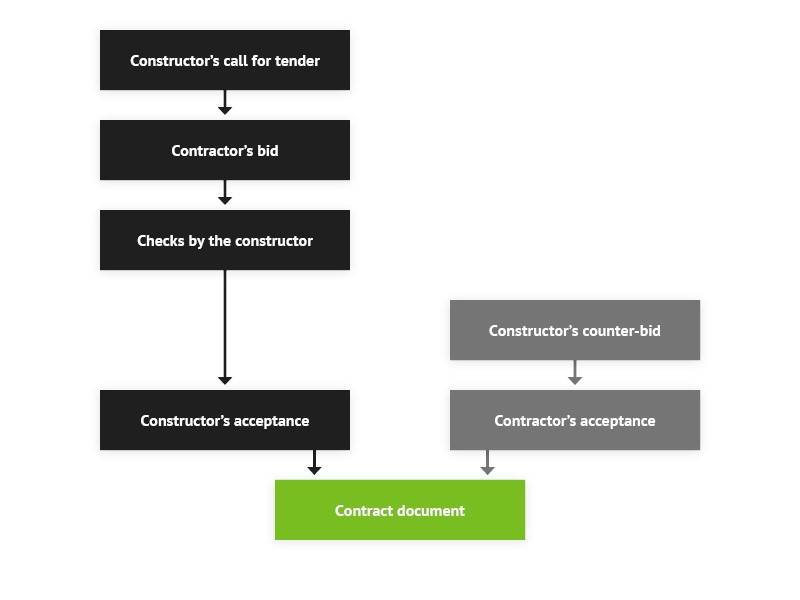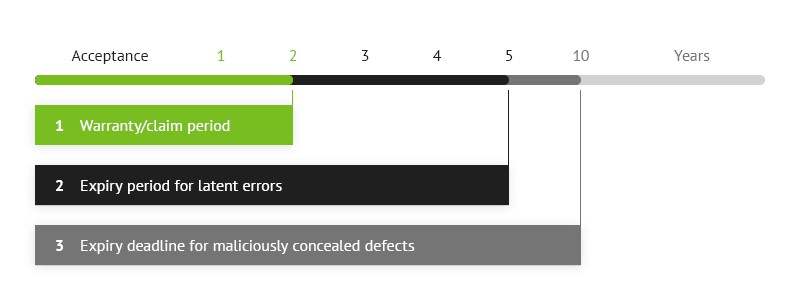Implementation phase
During the implementation phase, the construction project is prepared and concluded on the basis of the planning.

From the planning of deadlines up to the construction invoicing
The implementation phase puts into action what the planning has prepared for. The area of tension shifts, the protagonists are now the craftsmen and contractors with a high practice relevance. The complexity of the planning must be explained and supervised by the construction management. This field of tension is critically important and prone to error. Controls and documentation are now extremely important. So that this occurs within the determined scope, a continuous, independent checking of the work results, the control functions, and the documentation are indispensable. Construction auditing uncovers mistakes and insufficiencies before it is too late and an unstoppable avalanche is able to build up.
Deadline planning in the building trade includes the scheduling of activities for the planning, completion of the project and the checks on construction’s progress.
With the deadline planning it should be guaranteed that:
- the achievement of the project’s goals is possible within the timescales
- the human and mechanical resources, as well as the necessary materials, are available
- considerations of possible disruptions, such as dependencies upon work schedules in respect of building services are made possible in advice
- the intersections between the different project participants have been taken note of.
The project and construction management, on the grounds of the deadline plans developed by them, must check the contents of the deadline requirements for the whole period of the project. Deviations from the planned timetable must be taken note of and analysed in good time according to the goal-setting. Corrective measures are to be introduced immediately.
The construction management works in an object-oriented way and in close professional collaboration with the project management. It forms the connecting link between the planner and the building contractor. The construction management is first and foremost the fiduciary representative of the constructor for the completion of a project. They are entrusted with the coordination and controls of the creation of the construction units on site.
With larger-scale construction works, a description of the construction works precedes the conclusion of the construction contract. In doing so, the purchaser issues the invitation to multiple contractors, to offer them to bid on the grounds of the submission documentation for the implementation of the described works. With this invitation to bid, the purchaser opens the submission procedure, which is to lead to the conclusion of the construction contract. This procedure is according to SIA standard 118 in the outlined sequence.
When speaking of a project modification, we mean when significant deviations apply in connection with the approved project. It may arise, that during the implementation phase, in spite of serious, detailed planning, requests for project changes are made. Every request for changes to the project, whether from the user, constructor or the architect, poses the danger of cost overruns or a loss of transparency in the cost control, as the necessary decision-making documentation for the project change resolutions must be worked upon, mostly under great time pressures.
An important element in every project progression is that of cost monitoring. The construction auditing must, at all times, allow the planners and constructors an exact evaluation of the costs in respect of creditworthiness. In this way, changes to the project may be better estimated and decisions reached without great risks. In addition, cost overruns are recognised at an early stage and, if necessary, the relevant measures taken. Not least, a carefully conducted construction audit also helps the conclusion of the contractor’s accounting and the actual construction accounting. During the accounting, a distinction is made between the unit price contracts, global and fixed-price contracts and fee contracts. Scheduled works are remunerated according to actually executed uses. For scheduled works must often be arranged immediately, so that the progress of the remaining works is not delayed.
Price changes are understood as an over or under payment from increased or decreased wage cost projections or material prices in comparison with the original costing documents. Every change to the original costing documents is to be reported to the contractor.
According to SIA standard 118, distinctions are made between the following price types:
- unit prices: authorised price changes
- global prices: authorised price changes
- fixed-price: unauthorised price changes.
Essentially there are two different procedure types for price change accounting:
- the procedure with quantity certification
- the index-linked procedure of differing types.
The contractor introduces the acceptance with the completion statement. If the constructor waives a joint work acceptance with the contractor, then the work or work component is deemed to be accepted without defect. If the constructor takes the work into service himself, the work is deemed to be accepted. As a rule, upon acceptance a record is drawn up, which is signed by the construction management as well as the contractor.
The warranty and limitation periods for the construction works or individual work phases start to run from the day of acceptance. If nothing else has been expressly agreed, the warranty period (complaint period) consists of 2 years. Should further defects arise after construction acceptance, these may be claimed for during the warranty period. Latent errors have an expiry of 5 years. Rights relating to defects that the contractor has consciously ignored, on the other hand, only expire after 10 years.
Construction accounting represents comparison values for cost estimates and is the sole instrument, allowing third parties subsequently in a comprehensive, gap-free manner and without great expense, to orientate themselves. After the completion of the construction project and the accounting for construction costs, the construction invoicing is normally submitted to the grantor of subsidies. The construction work is deemed to be concluded in terms of cost, if the final loan accounting is available. It is as much a post-calculation instrument as well as a document for the conclusion of the object-specific investment loan. The loan accounting provides information to the relevant bodies which have approved the credit about the costs actually incurred by the completed building project.





